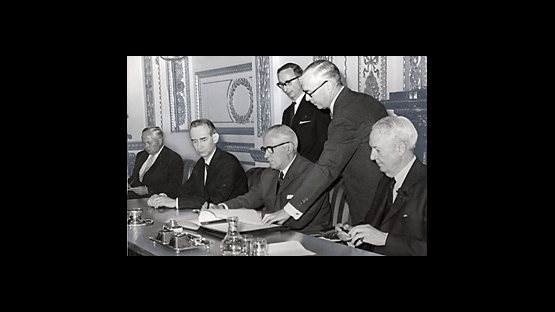The foundation of the nuclear non-proliferation regime is notching a significant milestone today. The Treaty on the Non-Proliferation of Nuclear Weapons (NPT) opened for signature on 1 July 1968, at ceremonies taking place in London, Moscow and Washington. Fifty-nine States would become signatories to the NPT that day. The Treaty would enter into force two years later, following ratification by 40 States Party. There are nearly 190 parties to the NPT today.
The IAEA plays a unique role in regards to the NPT, acting as competent authority responsible for verifying and assuring compliance of non-nuclear weapon States party to the NPT. The IAEA does this in accordance with its Statute and through its safeguards system, the mechanism by which the Agency provides credible verification assurances. The IAEA currently safeguards roughly 950 facilities in more than 70 countries.
Nuclear weapons pose a peerless global threat due to their extremely devastating power, and thwarting their spread requires international cooperation and effort. Yet in spite of the NPT´s importance in preventing proliferation of nuclear weapons, significant questions remain about its future effectiveness. Frequently cited concerns about the NPT include:
- The inequity of nuclear-weapon States versus non-nuclear-weapon States;
- Timetable for adherence to disarmament commitments on the part of nuclear-weapon States; and
- Non-universality of the NPT, as not every State has become party to the Treaty.
Background
Under the NPT, the United Kingdom, the Soviet Union (now Russian Federation) and the United States are designated as the Treaty´s depositary Governments.
The NPT has two classifications of parties - nuclear-weapons States (NWS), of which there are five, and non-nuclear-weapon States (NNWS). NWS are classified as the five States which had detonated a nuclear explosive device before 1 January 1967: these are China, France, the USSR (now Russian Federation), the United Kingdom and the United States. In general, the NNWS undertake not to develop nuclear weapons and to carry out only peaceful nuclear activities under IAEA verification, while the NWS are obligated to end the nuclear arms race and to work toward nuclear disarmament.
All States Parties are committed to cooperation in the peaceful uses of nuclear energy.
The NPT pioneered the practice of regular reviews by States Parties - the next NPT Review Conference will be held in 2010, and the third session of the preparatory committee for this conference will be in 2009. Both events are scheduled to be held in New York.


